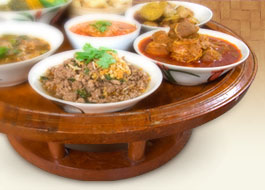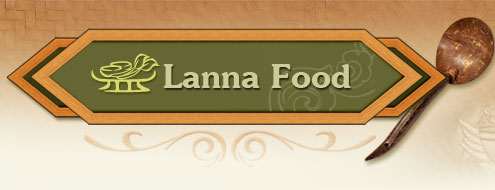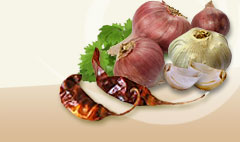Cucumber |
|
|
 | Cucumis stavus Linn. |
|
| |
 | Cucurbitaceae |
|
| |
 | Common Cucumber, Cucumber |
|
| |
 | Taeng Khikai, Taeng khikhua, Taeng sang, Taeng ran (Northern); Taeng pi, Taeng yuang, Taeng Hen, Taeng ham, Ta soa (Khmer) (Wut Wuthithamwet, 1997, p. 218) |
|
| |
 | Climber, annual, triangular leaves, lobate, female yellow flowers in a cluster or pairs, tubular with 5 petals. Young fruit are greenish white with short spines or prickly, yellow when ripe. Numerous seeds that are flat and white. The plant comes in quite a variety and names depending on the characteristics and habits. Some are large, some are small or fragrant. (Rangsan Chanta and Rattana Phromphichai, 1999, pp. 2577-2578) |
|
| |
 |

Not much Vitamin C, iron and calcium. (Tawithong Hongwiwat, 2004, 99). They are normally eaten fresh before they mature with namphrik, yam or spicy foods or stir-fried with pork or sa (larger size is preferable). |

Leaves taste bitter and are unpalatable, used as an emetic or to relieve upset stomach. Fruit has a cooling taste, used as a tonic, laxative, to stimulate urination, as an anti-inflamation, for softening the skin, whiting the skin, to prevent bladder stones. Mature fruit is hollowed out or (the seeds taken out) and alum is inserted. It is then grilled to extract the liquid to be used for eliminating kidney stones and encourage urination. Seeds can be used to encourage urination and as a tonic, but it is not good for rheumatism. The root also has a cool taste, used to induce urination or prevent Vitamin B6 deficiency. (Wut Wuthithamwet, 1997, p. 218) |
|
| |
 |
Thawithong Hongwiwat. (2004). Saranukrom Phak (Vegetable Encyclopedia). 2nd ed. Bangkok: Saengdaet. (in Thai). Rangsan Chanta and Rattana Phromphichai. (1999). Taeng. in Saranukrom Wattanatham Thai Phak Nuea (Vol. 5, pp. 2577-2578). Bangkok: The Siam Commercial Bank Foundation for the Encyclopedia of Thai Culture. (in Thai). Wut Wuthithamwet. (1997). Saranukrom Samunphrai: Ruam Lak
Pesatchakam Thai. Bangkok: Odean Store. (in Thai). |
|
| |
|
|




